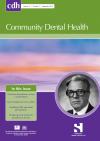Community Dental Health

- Cover Date:
- September 2015
- Print ISSN:
- 0265 539X
- Vol:
- 32
- Issue:
- 3
Dental caries in Iraqi 12-year-olds and background fluoride exposure
Community Dental Health (2015) 32, 163–169 Received 24 September 2014; Accepted 3 April 2015
doi:10.1922/CDH_3514Matloob07
Dental caries in Iraqi 12-year-olds and background fluoride exposure
M.H. Matloob
Objective: The aim of this study was to assess the prevalence and severity of dental caries among 12-year-old Iraqi schoolchildren ingesting water and beverages with low fluoride content. Method A total of 1,526 twelve-year-olds were clinically examined in autumn 2013 for dental caries in accordance with the WHO criteria. Two questionnaires were distributed to gather data concerning daily intakes of drinking water, beverages and tea extracts and how often participants brushed their teeth, visiting doctors and eating snacks between meals. The fluoride content of 279 brands of drinking water, beverages, tea, toothpaste and table salts were determined using fluoride ion selective electrode. Results The mean DMFT and SIC index were 1.6 (SD 1.7) and 3.5 (SD 1.4) respectively. The caries prevalence was 64.0%, and the Care Index was 1.9%. The average fluoride content of drinking water, beverages, toothpaste and food was less than 0.50 mg/kg. Conclusion The mean DMFT value for Iraqi 12-year-olds is still higher than the WHO category of very low caries (<1.2). The daily fluoride exposure by 12-year-old Iraqi children was too low for caries prevention. In order to improve the oral health status, the Iraqi health authorities had to focus more care on the preventive oral health programme.
Key words: caries, Iraqi DMFT index, significant caries index (SiC), fluoride in water and beverages
- Article Price
- £15.00
- Institution Article Price
- £
- Page Start
- 163
- Page End
- 169
- Authors
- M.H. Matloob
Articles from this issue
- Title
- Pg. Start
- Pg. End
- Relationship between family characteristics and children’s regular toothbrushing with fluoride toothpaste
- 132
- 136
- Effect of family caregiver oral care training on stroke survivor oral and respiratory health in Taiwan: a randomised controlled trial
- 137
- 142
- Association of oral health literacy with oral health behaviour and oral health status in Belarus
- 148
- 152
- Comparing UK, USA and Australian values for EQ-5D as a health utility measure of oral health
- 180
- 184
